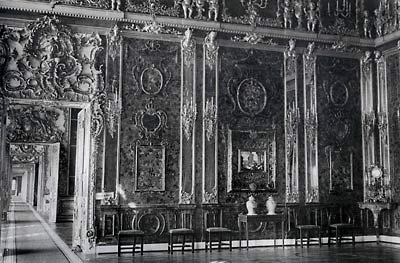
In 1716, Russian Tsar Peter I visited Berlin, admired the amber masterpiece, and Frederick Wilhelm I asked Peter the Great to accept the unusual room as a diplomatic gift. The Russian Tsar’s return present was no less original: 55 choice grenadiers. After a long shipping time and complex route (Berlin-Koenigsburg-Memel-Riga-St.Petersburg) the Amber Room finally reached its destination. The boxes were unpacked but the Russian masters did not manage to reconstruct the Amber Room, and it was for some time forgotten.
When Empress Elizabeth started reigning in the 1740s, she commissioned her chief architect, Bartolomeo Francesco Rastrelli, to use the amber for decoration of one of the rooms of the Winter Palace. The room was too large, and the architect used mirrored pilasters and painted additional panels in “fake amber”. In 1755, the Amber Room was transferred to the Catherine Palace in Tsarskoje Selo where the new room was to be constructed. The room in the Palace was again too large for the Amber Study, and the amber parts were reassembled on the walls alternating with pilasters and mirrors. The places where the amber was missing, were painted in “fake amber” and afterwards replaced with real amber panels. By 1770 the Amber Room was complete. However the amber was damaged by the stove heating and temperature changes, and the room was restored three times: in 1833, 1865, and in the 1890s. The next restoration was to take place in 1941.
– destroyed by the Allies’ bombing,
– buried in a silver mine not far from Berlin,
– hidden on the shores of the Baltic Sea.
Nothing is found yet, though parts of the mosaics appeared in the 1990s in Germany. Thus, the 50-year-old mystery of Amber Room is still alive.
Related articles:
Intrigue and Mystery of the Amber Room
Reconstruction of the Amber Room
